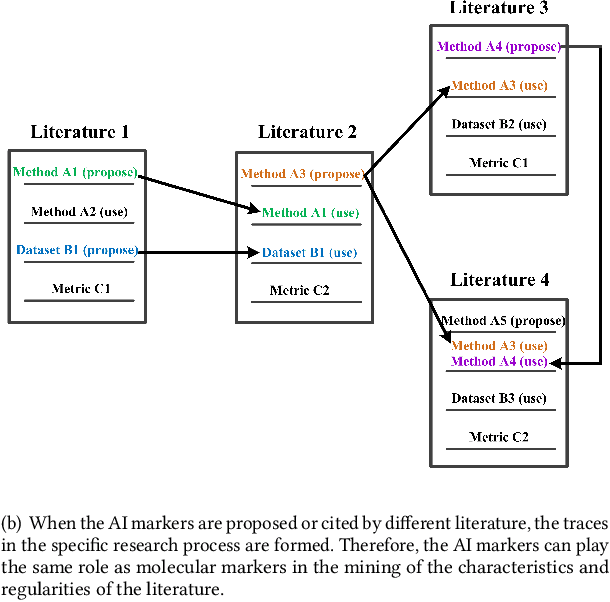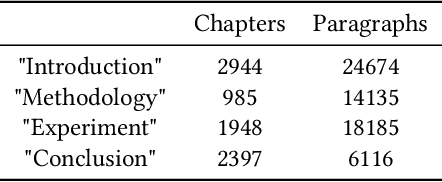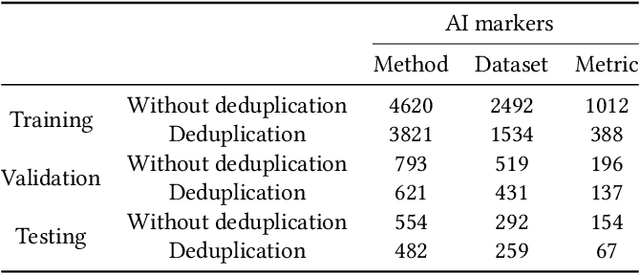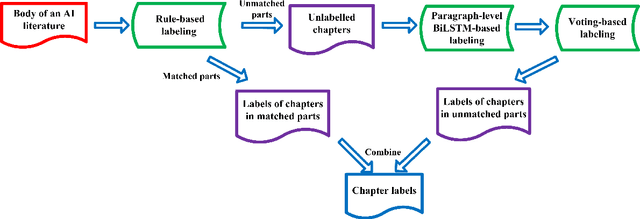Yingchun Ye
AI Marker-based Large-scale AI Literature Mining
Nov 03, 2020



Abstract:The knowledge contained in academic literature is interesting to mine. Inspired by the idea of molecular markers tracing in the field of biochemistry, three named entities, namely, methods, datasets and metrics are used as AI markers for AI literature. These entities can be used to trace the research process described in the bodies of papers, which opens up new perspectives for seeking and mining more valuable academic information. Firstly, the entity extraction model is used in this study to extract AI markers from large-scale AI literature. Secondly, original papers are traced for AI markers. Statistical and propagation analysis are performed based on tracing results. Finally, the co-occurrences of AI markers are used to achieve clustering. The evolution within method clusters and the influencing relationships amongst different research scene clusters are explored. The above-mentioned mining based on AI markers yields many meaningful discoveries. For example, the propagation of effective methods on the datasets is rapidly increasing with the development of time; effective methods proposed by China in recent years have increasing influence on other countries, whilst France is the opposite. Saliency detection, a classic computer vision research scene, is the least likely to be affected by other research scenes.
Method and Dataset Entity Mining in Scientific Literature: A CNN + Bi-LSTM Model with Self-attention
Oct 26, 2020



Abstract:Literature analysis facilitates researchers to acquire a good understanding of the development of science and technology. The traditional literature analysis focuses largely on the literature metadata such as topics, authors, abstracts, keywords, references, etc., and little attention was paid to the main content of papers. In many scientific domains such as science, computing, engineering, etc., the methods and datasets involved in the scientific papers published in those domains carry important information and are quite useful for domain analysis as well as algorithm and dataset recommendation. In this paper, we propose a novel entity recognition model, called MDER, which is able to effectively extract the method and dataset entities from the main textual content of scientific papers. The model utilizes rule embedding and adopts a parallel structure of CNN and Bi-LSTM with the self-attention mechanism. We evaluate the proposed model on datasets which are constructed from the published papers of four research areas in computer science, i.e., NLP, CV, Data Mining and AI. The experimental results demonstrate that our model performs well in all the four areas and it features a good learning capacity for cross-area learning and recognition. We also conduct experiments to evaluate the effectiveness of different building modules within our model which indicate that the importance of different building modules in collectively contributing to the good entity recognition performance as a whole. The data augmentation experiments on our model demonstrated that data augmentation positively contributes to model training, making our model much more robust in dealing with the scenarios where only small number of training samples are available. We finally apply our model on PAKDD papers published from 2009-2019 to mine insightful results from scientific papers published in a longer time span.
Method and Dataset Mining in Scientific Papers
Nov 29, 2019



Abstract:Literature analysis facilitates researchers better understanding the development of science and technology. The conventional literature analysis focuses on the topics, authors, abstracts, keywords, references, etc., and rarely pays attention to the content of papers. In the field of machine learning, the involved methods (M) and datasets (D) are key information in papers. The extraction and mining of M and D are useful for discipline analysis and algorithm recommendation. In this paper, we propose a novel entity recognition model, called MDER, and constructe datasets from the papers of the PAKDD conferences (2009-2019). Some preliminary experiments are conducted to assess the extraction performance and the mining results are visualized.
 Add to Chrome
Add to Chrome Add to Firefox
Add to Firefox Add to Edge
Add to Edge